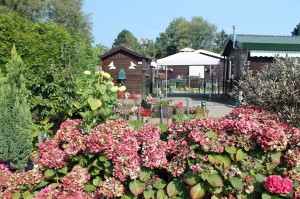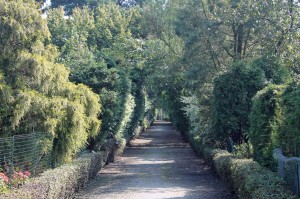A Community of Gardens
September 23rd, 2014
Picture a 20-acre neighborhood where everybody’s a gardener and all of the yards are filled with flowers, shrubs and veggies.
Then add small cottages, shady gravel lanes and a green community square in the center, and you have what’s called a “garden park.”
I’d never seen this concept until I ran across one last week in the Netherlands while visiting my daughter, who got a job there last year.
The plant-loving Dutch have garden parks like these all over their urban areas. Amsterdam alone has 29 of them in and around the city.
The one I saw is called Tuinpark Nut and Genoegen, and it’s got 375 garden lots spread over 20 acres in Amsterdam’s public Westerpark.
It’s somewhat like what we know as a community garden in which people with small or no yards can rent a section of carved-up common land, usually to grow vegetables.
That’s how most of the Dutch garden parks sprang up in the 1920s – as a way for land-starved urban residents to grow some of their own food.
But after World War 2, the parks started morphing into blends of edibles and ornamentals, including trees, shrubs and evergreen screen plantings.
Typical lot sizes are only about 1/10th of an acre or less – tiny by our standards but heavenly to a compacted Amsterdammer accustomed to yardless apartments and wall-to-wall bikers on skinny streets.
Most of the plots I saw have small cottages or what we’d call sun rooms built on them.
The buildings aren’t intended for full-time living. In fact, garden-park rules tell you that these places can’t be your primary residences, although you can stay overnight and use them as you would a vacation home.
Tuinpark Nut and Genoegen is completely bounded by canals and three gated entries, so there is some security and privacy.
It’s divided by 23 gravel lanes that are lined on each side by garden plots, most of which have gates or arbors to mark entry.
Much of the garden park is shaded by tall trees and evergreens. It reminded me a bit of the cottages at Mt. Gretna, except with even more plantings.
The plot owners customize their space to suit their tastes.
Some have planted grassy patches to give children and pets a place to run around.
Others went with cozy, shaded nooks with patio furniture or picnic tables.
Still others wanted to maximize sunlight, so their plots were open, treeless and more formal in design.
And a lot of people had small herb and vegetable plots or topiary fruit trees.
It’s a pretty cool concept… like taking a community vegetable garden one step beyond into something akin to urban rent-a-yards.
I think it would go over fairly well in our urban areas, especially given the recent boon in community gardening.
The way the Dutch pulled it off is by having the city governments set aside the land and turning it over to private garden-park associations to run.
People buy their spaces as opposed to just renting them, but they don’t actually own the land. The governments technically own the land.
People are free to make improvements and change the plot as they wish, so long as it’s within the association rules. There’s also an annual maintenance fee. In those respects, it’s a bit like our condo associations.
When you’re done with the space, you’re free to sell. But since garden parks aren’t private ventures built by profit-motivated developers, you don’t sell for whatever price you can get.
The association keeps a lid on prices – currently running in Tuinpark Nut and Genoegen at between just $4,000 and $20,000, depending on the size plot and the improvements on it.
On one hand, that prevents you from making much of a profit on the venture.
But on the other, it keeps the whole idea affordable to the non-affluent and more of a lifestyle choice than an investment.
There’s no shortage of demand. I heard that some of the garden parks have waits of up to 5 years to buy one.
I’m sure that if I lived in a crowded city like Amsterdam – or any city, for that matter – I’d be on the list.










